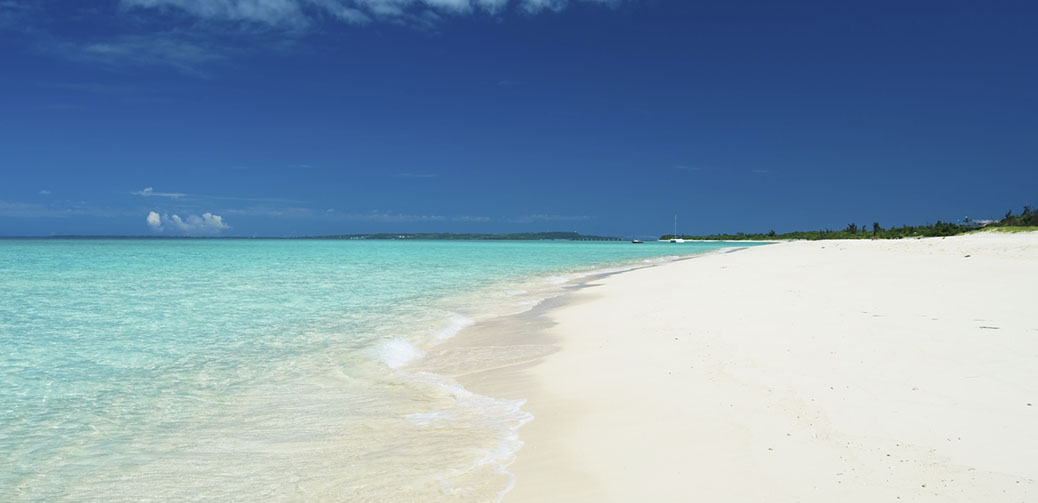Southeast Asia tends to grab all the attention when it comes to finding top beaches but don’t forget Japan. If you’re a beach aficionado searching for something a little more exotic, look further east. The Japanese don’t shout about their beaches, but if you know where to look, you’ll find semi-tropical beaches of pristine white sand with water as clear as any beach in the Maldives. Here is a list of the five best beaches in Japan, promoted by Audley Travel’s Japan specialists.
Yonehara Beach, Ishigaki Island
Only 75 miles off the coast of Taiwan, the island of Ishigaki has its own language. English is rarely spoken here, and few visitors to Japan make it this far out, despite a direct flight from Tokyo. The water around the island is so clear that flying over it, you can see a ring of coral circling the coast.
The volcanic coastline is interspersed with stretches of porcelain-white sand framed by dwarf pine trees. Kariba Bay is the most well-known beach, with uninhabited jungle-covered islands mushrooming from the sea beyond. With swimming banned to protect the resident groups of manta rays, the beach is best appreciated with a glass-bottomed boat, from where you can watch the marine life below.
Head east along the coast, and as the buildings begin to thin out, you’ll find Yonehara Beach. The grove of palms running adjacent to the coast is an ideal spot to relax and enjoy the view, but you’re really here for the coral. The reef is a short paddle from the beach and has enough marine life to rival an aquarium. Part of Iriomote-Ishigaki National Park, some of the world’s largest collections of coral are found here as well as neon butterfly fish and psychedelic angelfish.
Kondoi Beach, Taketomi Island
A ten-minute ferry ride from Ishigaki brings you to the tiny islet of Taketomi. There are no fast-food restaurants or T-shirt sellers here. The residents, in a strong vote of civic pride, have banded together to preserve the culture of their island. You’ll find a cluster of houses with Red-Kawara (tile) roofs surrounded by hand-packed stone walls and tropical flowers and intersected by narrow sandy roads.
Kondoi Beach is a bleached-white stretch of sand leading into warm, calm water. Aside from a small changing room and a few blue and white parasols, it’s undisturbed. The sea here is shallow enough to swim safely right out to the sandbanks, where the ocean turns a rich emerald green. Travel further around the coast, and you might find some Hoshizuna (star sand), made from millions of tiny star-shaped fossils.
A lack of motorized transport adds to the laid-back feel of Kondoi Beach. You can hire bicycles or join the local people in a traditional taxi – a cart pulled by water buffalo – to explore the island. It makes an ideal day trip, but choose to stay on the island, and you’ll have the beaches to yourself. Come the evening, the island pace slows to a standstill, and the lights switch off one by one, leaving the island in an inky darkness. Venture to the beach, and you’ll find it lit by starlight – the streak of the Milky Way is a common sight.
Funauki Beach, Iriomote Islandg
Almost completely covered in jungle and mangrove swamps, Iriomote is a wild island. Its few villages are sparse and predominately focused near the ferry terminal that shuttles visitors from nearby Ishigaki Island. Take a guided walk along one of the jungle trails, and you’re likely to encounter some of the many untouched and unnamed sandy coves that indent the island’s coastline.
To see why this island has been designated a national park, take a guided kayak tour to Funauki Beach. This remote stretch of honey-colored sand can only be reached from the sea. A tranquil environment, it has become a refuge for wildlife, from the rare Yamaneko (wild cat) to flourishing coral reefs and populations of manta rays.
Funauki’s powder-fine sand is ideal to laze on, shaded by the boughs of the mango trees that stretch down to the sea. From here, the jungle-clad coast rises steeply, keeping the beach hidden from nearby Funauki village, a settlement of about 50 people. Take a picnic, and you can enjoy an afternoon snorkeling the reefs before kayaking back to civilization.
Maehama Beach, Miyako-jima Island
Regularly voted Japan’s best beach by travel publications worldwide (and pictured above), Maehama has a reputation to uphold. It’s hard to be disappointed with the 7 km (4 miles) of sand so white that it glows in the sun. The beach shelves gently into calm, balmy water. The sea is a bright aquamarine, with a band of dark blue across the horizon marking the ocean drop-off.
Despite its many visitors, the beach is long enough to rarely feel crowded. Arrive in the early morning to walk the promenade, and you’ll usually have it to yourself. West-facing Maehama puts on a show every evening as the sun sets and shoots shocks of pink-red across the sky.
Located on the island of Miyako-Jima, Maehama Beach is a 30-minute flight from Ishigaki Island, and most visitors choose to island-hop between beaches. It’s one of Japan’s more traditional beach destinations, so you’ll find water sports and beachside restaurants – many specializing in high-quality Yakiniku (slices of beef grilled at the table).
Shirahama Beach, Izu Peninsula
You don’t have to travel to the outposts of Japan to find a great beach. The Izu Peninsula juts out from the south of Honshu Island, just 100 km (62 miles) from Tokyo. It’s a rugged, volcanic landmass centered around the Anagi Mountains, which drop sharply down to meet long slithers of white sand and clear water.
On the weekends, Shirahama Beach on the peninsula’s east coast is a seaside Tokyo. The crowds are continuously fed by buses from the city, and the sand blooms with bright parasols. Visit mid-week when the beach is quieter, and you can see why it’s so popular. A long curve of sand framed with grottos of volcanic rock leads into the bright turquoise water. A red torii gate sits up on the rocks – a reminder that you’re still in Japan.
Arguably, the beach is best enjoyed while soaking in one of the many Onsen (open-air baths fed by natural hot springs) that sit on the hillside looking out over the bright blue bay. Many are communal, but it’s possible to book a private pool. After bathing, you can eat at one of the restaurants offering fine seafood – takahashi crab (the world’s largest crab) is a regional specialty.
You may be interested in which beaches top my list as the top 10 white sand beaches in the world.
Copyright Luxury Travel Diary 2014 - 2024. Duplication outside of luxurytraveldiary.com is forbidden.
Note: Benefits & upgrades subject to availability. Benefits offered correct at the time of writing. Terms & conditions apply. Enquire for more information. Posts may be sponsored by the proprietor or brand being appraised. All opinions remain our own & are in no way influenced.















